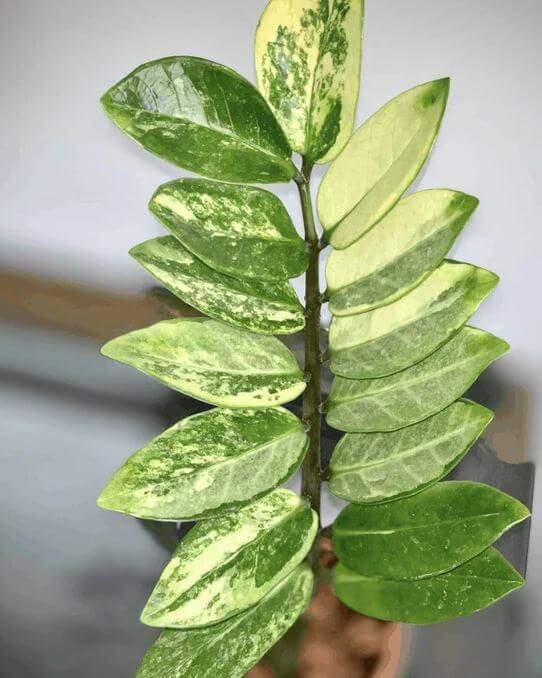Last Updated on January 6, 2023 by a Friendly Gardener
The Variegated ZZ Plant (Zamioculcas zamiifolia ‘Variegata’) is a very easy-to-grow houseplant. Bred for its stunning variegated foliage, the variegated ZZ plant is a very popular ornamental house plant that looks eye-catching as decoration in homes.
The attractive, glossy, upright green leaves with their creamy-white variegated coloring make the ZZ plant variegated perfect for corner side tables in any room.
What’s more? The variegated ZZ plant can purify the air in your home by filtering the air and removing harmful toxins such as benzene, ethylbenzene, xylene, and toluene and providing oxygen.
In this article, we’ll cover all you need to know about the variegated ZZ plant.
About the Variegated ZZ Plant
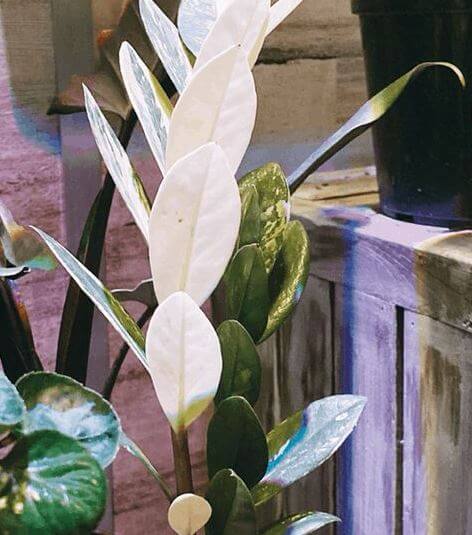
The variegated ZZ plant (Zamioculcas zamiifolia ‘Variegata’) is a type of Zamioculcas zamiifolia plant, which is a species belonging to Zamioculcas, which is a genus of flowering plants in the Araceae family.
Zamioculcas zamiifolia is also known by other common names including ZZ plant, Zuzu plant, Zanzibar gem, aroid palm, emerald palm, and eternity plant, and is native to the region from Kenya to northeastern Africa.
The variegated ZZ plant is a slow-growing plant, which grows to around 2 to 3 feet in height, but it takes a few years before the plant reaches its maximum growth.
The variegated plant bears yellow, bronze, and brown-colored blooms that appear from mid-summer to early fall.
Some of the different types of the Zamioculcas zamiifolia plant include:
- Zamioculcas zamiifolia ‘Classic’: This variety has leaves that are more rounded and less pointy.
- Zamioculcas zamiifolia ‘Raven’: The variegated raven ZZ plant has distinctive dark purple-maroon colored foliage and light green-colored new leaves that give it a stunning look.
- Zamioculcas zamiifolia ‘Zamicro’: This is the dwarf version of the Zamioculcas zamiifolia plant and has short stems and small leaves.
- Zamioculcas zamiifolia ‘Zenzi’: This is a rare variety of the ZZ plant and has curly leaves that are clustered on the top of the stem.
Variegated ZZ Plant Care
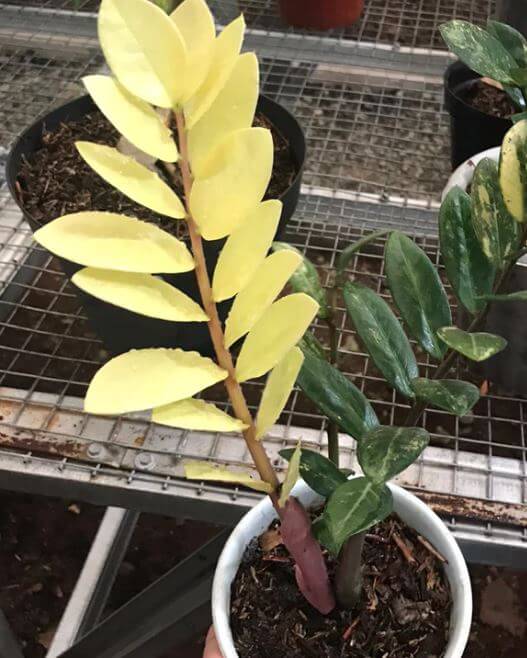
The variegated ZZ plant is a very low-maintenance plant and is popular for its adaptive abilities, making it the perfect houseplant. In this section, we’ll discuss all the variegated ZZ plant care.
Light
The variegated ZZ plant can tolerate varying lighting conditions right from bright to moderate light to partial shade. And, this makes it ideal for growing indoors.
The plant can tolerate a few hours of direct sunlight. But the full, direct sun, especially during the hot summer months, can scorch the leaves and make them curl or turn yellow.
Inadequate light can make your plant leggy and they can lose their variegation. So, when keeping your ZZ plant indoors, place it in a spot where there is bright, indirect light, preferably near a south-facing window.
Temperature and Humidity
The variegated ZZ plant grows well in average temperatures (around 65°F to 85°F) and humidity conditions in the home.
The plants cannot withstand cold temperatures of below 45°F and so, you should not place the plant in cold areas in your home or close to drafts.
The variegated ZZ plant is not very fussy about the humidity levels but does well when the humidity is around 40%.
To ensure that there is sufficient humidity, you can mist the plant with soft or distilled water. Don’t place the plant near sunny windows or heat sources as this will cause the air around the plant to dry out.
Soil

The variegated ZZ plant needs fertile, well-draining soil. You can use regular potting mix, but if you need additional drainage, then you can add some sand or perlite to it. The plant does well in acidic to neutral soil with a pH between 5.6 and 7.5.
Water
The variegated ZZ plant is highly drought tolerant and can thrive even if watered infrequently because of its thick rhizomes that store water.
Depending on the growing conditions, you must water the plant when the soil dries out fully, typically once every 2 weeks.
It is better to water the ZZ plant less rather than overwater it because this can cause your plant to die. If the leaves of the plant are turning yellow, it means that the plant is being overwatered.
If the temperature in your area is high or your plant is exposed to plenty of sunlight, then you may need to increase the frequency of watering. But in low light conditions or during the winter months, watering the variegated ZZ plant once a month is sufficient.
When watering the plant, ensure that the soil is thoroughly wet until the water comes out of the drainage holes at the bottom of the container. Throw away the excess water and avoid the plant sitting in the water.
Fertilizing
The variegated ZZ plant does not need regular feeding to grow, but fertilization encourages the growth of the plant. Use a diluted indoor plant fertilizer to feed the plant 1-2 times during its growing season.
Repotting and Pruning
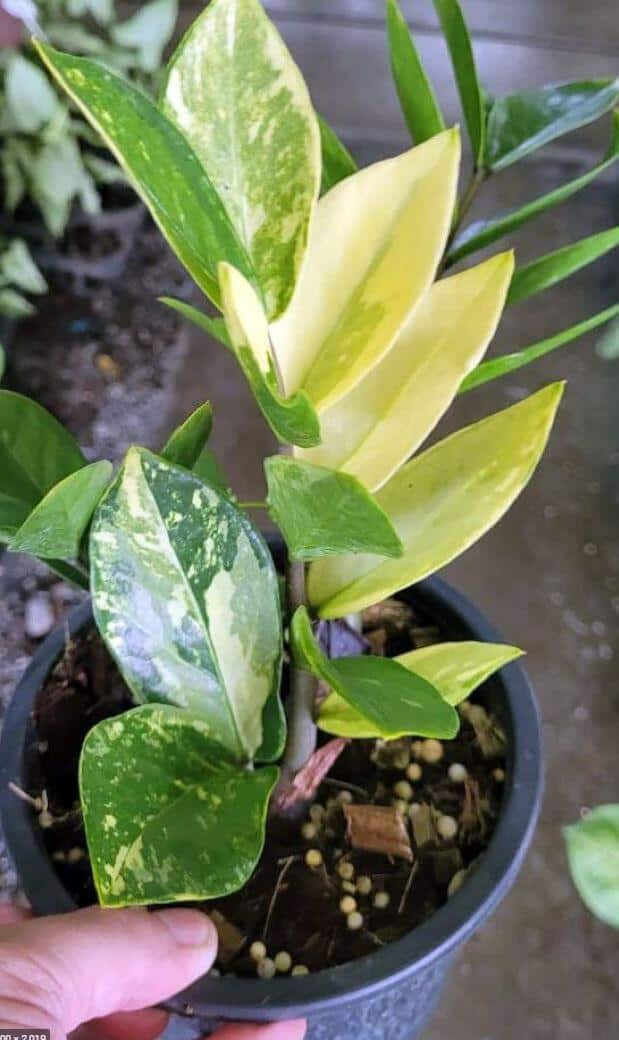
When the plant outgrows its pot/container, you must repot it. If you see the leaves of the plant curling, then it may mean that the roots don’t have sufficient space and have become bound.
Repot the plant once every 1-2 years by transferring it into a bigger pot that is around 1-2 inches larger. The best time to repot the plant is during the summer and spring months when the plant is the strongest.
Use a good potting mix and add some sand and compost to improve the drainage. Ensure that the plant has proper drainage because it will die if its roots are sitting in water continuously.
Make sure that the new container that you’re using for repotting has one hole for drainage at least. Pruning any yellowing or dying foliage will help the plant to grow well. Pruning the old stems of the plant will help to make it look neat and tidy.
Variegated ZZ Plant Propagation

The variegated ZZ plant can be propagated by stem cuttings, division of the rhizome, and leaf cuttings.
Wrapping Up
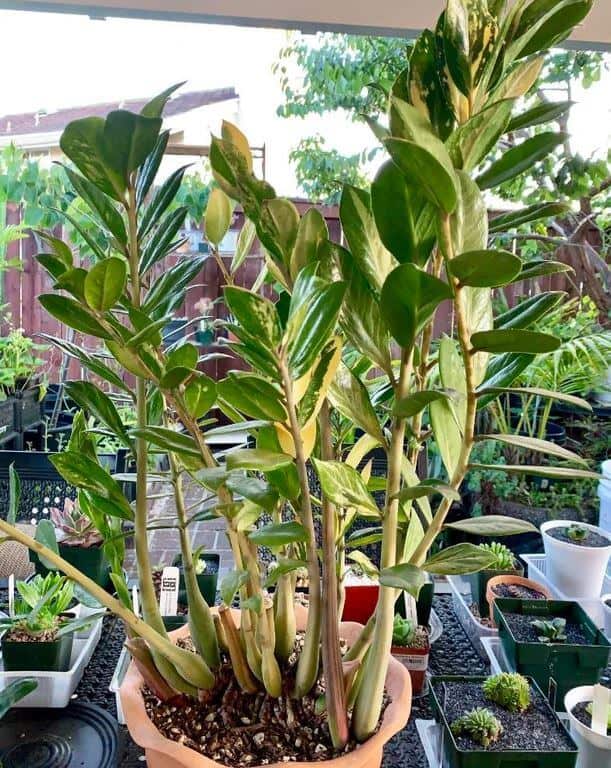
Variegated ZZ plants are beautiful, low-maintenance, easy-to-care-for houseplants that are perfect for you if you’re a frequent traveler or a forgetful gardener.
These classic, ornamental houseplants can withstand a range of indoor conditions and do well even in low-light conditions for many months, making them excellent additions to your indoor space.

